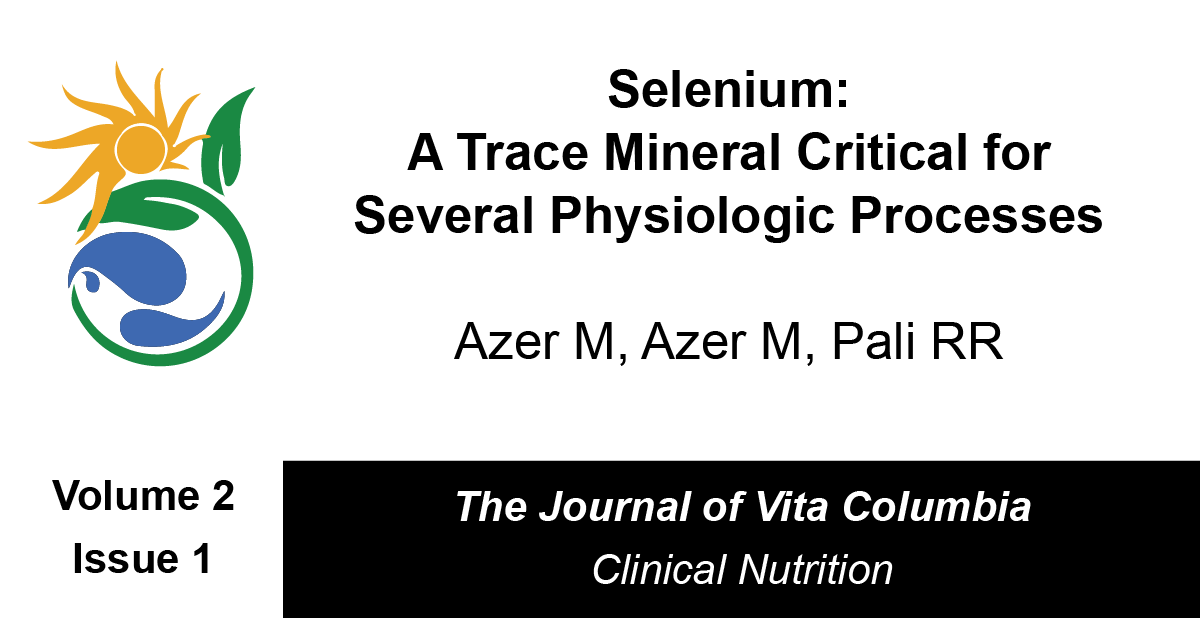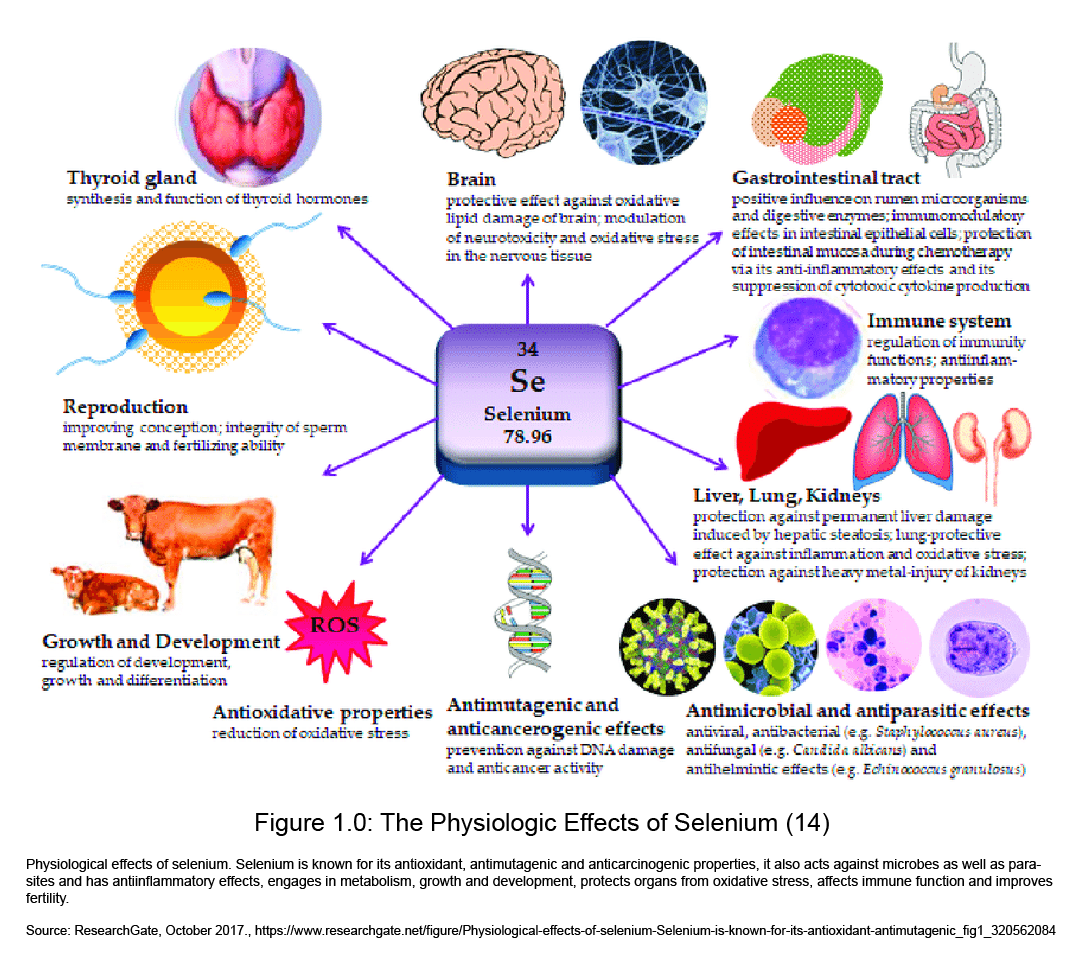
Journal of Vita Columbia Volume 2 Issue 1 – Clinical Nutrition
Selenium: A Trace Mineral Critical For Several Physiologic Processes
January 18th, 2022
How to cite this article:
Azer M, Azer M, Pali RR. Selenium: A Trace Mineral Critical For Several Physiologic Processes. 2022. Journal of Vita Columbia. 2(1).
Abstract:
A non-metal with an atomic number of 34, selenium is on the periodic table as one of the fundamental elements of our universe. As in our universe, selenium is also a fundamental element of our bodies, forming enzymes that aid in DNA synthesis, thyroid hormone metabolism and is key in our reproductive function. So what happens when we are low on this crucial element in our bodies? What about if we go into toxicity? Read on to find out.
Introduction:
The human body needs a small amount of selenium; hence it is one of the trace minerals. (1) It can be found in many kinds of food such as oysters, Brazil nuts, halibut, tuna, eggs, sardines, sunflower seeds and chicken breasts. (2) However, the exact amount of selenium in plants depends on the selenium content of the soil they grow. (2) This soil content varies according to many factors such as rainfall, evaporation and pH level. (2) Selenium bioavailability varies according to the source and nutritional status of the subject, being significantly higher for organic forms of selenium. Selenium supplements can benefit subjects living in regions with low environmental selenium levels. Several strategies have been followed: (a) employment of selenium-enriched fertilizers; (b) supplementation of farm animals with selenium; (c) consumption of multimicronutrient supplements with selenium. Considering the various sources of selenium, Suppliers also need to provide more information on the specific type of selenium used in supplements. (3)
Selenium is a crucial component of many proteins and enzymes, some called (selenoproteins). These proteins help in DNA synthesis, protect against cell damage, thyroid hormones metabolism, and reproductive function in females and males (2).
Metabolism of Selenium
As earlier stated, selenium (Se) is an essential trace element for humans, plants and microorganisms. Inorganic selenium is present in nature in four oxidation states: selenate, selenite, elemental selenium and selenide in decreasing order of redox status. All biological systems convert these forms into more bioavailable organic forms. Mainly as the two seleno-amino acids, selenocysteine and selenomethionine. Humans, plants and microorganisms can fix these amino acids into proteins originating selenium-containing proteins by a simple replacement of methionine with selenomethionine, or “true” selenoproteins if a specific UGA codon genetically encodes the insertion of selenocysteine. (4)
From the diet, selenium obtained in organic forms (selenomethionine and selenocysteine) and inorganic forms (selenite and selenate) is taken up by the liver that synthesizes and exports selenoprotein P (SELENOP), which eventually circulates through the bloodstream. SELENOP, with multiple selenocysteine residues, transports selenium to other tissues and organs. The transported selenium is converted to selenophosphate by intracellular selenium metabolic pathways. In small-molecule metabolites formed by sequential methylation, selenium is excreted through exhalation and urine. Selenium plays biological roles predominantly as selenoproteins, synthesized by the selenium metabolic system. (5)
The Role of Selenium in the Human Body
- It has a strong antioxidant effect, protecting the cell from being damaged by free radicals.
- Decreases the risk of malignancy.
- Decreases the chances of heart disease.
- Prevention of mental decline.
- It is vital for thyroid function as it contains the highest amount of selenium in the human body.
- It boosts the immune system.
- Improves asthma symptoms.

Considering the role of selenium in the human body, we can see why its adequacy is essential, especially for certain groups more susceptible to selenium deficiency. These groups include patients with Graves or other thyroid diseases, patients who suffer from malignancies or weak immune systems, and pregnant women. (2)
More research is needed in certain areas where the role of selenium is essential. For example, research is lacking on the mechanisms through which selenium is involved in hepatocyte damage during hepatopathies. However, selenium potential as an antioxidant for preventing cardiovascular diseases (CVD) is promising. (6) However, additional long-term intervention trials are necessary. As a result, indiscriminate selenium supplements cannot be reliably recommended to prevent CVD in human beings. Some interesting findings reported an association of selenium intake with a reduced prevalence and risk for prostate and colon cancer. However, random trials for other cancer types are inconclusive. In conclusion, the general population should be cautioned against using selenium supplements to prevent hepatopathies, cardiovascular or cancer diseases. The benefits of selenium supplementation are still uncertain in these cases, and the indiscriminate use of supplements could generate an increased risk of selenium toxicity. (3)
Selenium Deficiency:
While selenium deficiency may be rare in the United States and Canada, around 1 billion people still suffer from it worldwide. (2) It is more common in China, Russia and some European countries. (1)
Some risk factors of selenium deficiency include living in areas with soil low in selenium level, especially in those who follow a vegan diet, dialysis patients, HIV patients and those with digestive disorders (such as inflammatory bowel disease). (2,7)
Symptoms of Selenium Deficiency
Selenium deficiency may be manifested as the following symptoms (1,2):
- hair loss
- nausea
- vomiting
- headaches
- muscle weakness
- fatigue
- mental disturbance
- infertility
- weak immune system
- seizures
- coma
Severe deficiency of selenium can lead to Keshan disease or Kashin Beck disease. (1)
Keshan disease is named after a county in China where it was first reported in 1935. Keshan disease is a fatal type of cardiomyopathy responsible for high morbidity and mortality rates in China. (8) It can be acute or chronic, and while many theories have been discussed about the etiology, the main reason is believed to be selenium deficiency. (8) Patients suffering from Keshan disease show congestive heart failure, acute heart failure and cardiac arrhythmia. (8)
Kashin beck disease (KBD) is a chronic joint inflammatory disorder that can lead to disability. It is common in Siberia, North Korea and China, where around 1 million people are affected (9). When it strikes in childhood, it may lead to dwarfism, significantly if it affects children around two years.
The disease develops symmetrically, beginning with and mainly affecting the distal joints of upper and lower limbs, causing inflammation and damage. (9)
Diagnosis of Selenium Deficiency
- The most commonly used measures of selenium status are plasma and serum selenium concentrations. (7)
- The selenium level in blood or urine gives an idea about the recent intake. (7)
- Analysis of nail or hair selenium content reflects long-term intake. (7)
Prevention & Treatment of Selenium Deficiency
- 15 mcg is recommended from o to first six months of life. (11)
- 20 mcg is needed from 6 months to three years old. (11)
- From four to eight years old, 30 mcg is recommended daily. (11)
- 40 mcg daily is good from nine to thirteen years old. (11)
- The recommendation is for people older than fourteen years to ingest 55 mcg of selenium daily. (2)
- Pregnant and lactating women need around 70 mcg daily; if suffering from pre-eclampsia, the dose can be increased up to 100 mcg for six months. (2, 11)
Selenium Deficiency & Covid-19:
Selenium deficiency has been associated with mortality risk from Covid 19; this is from studies made from samples taken from Covid 19 patients, showing a solid correlation pointing to an insufficient selenium availability for optimal selenoprotein expression. The selenium levels in surviving patients were higher than that in non-surviving patients. Also, because of the high importance of selenium in immune response, the mortality risk from a severe disease like sepsis or polytrauma is inversely related to selenium status (10)
Selenium Toxicity:
Despite the vital role of selenium, a high selenium level in plasma can be dangerous and fatal. (2) Above 900 mcg of selenium of daily ingestion can be toxic. (2)
Some indicators for selenium toxicity include (1,2):
- bad breath
- metallic taste
- brittle nails
- skin lesions
- hair loss
- dizziness
- nausea
- vomiting
- tremors
- muscle aches
- facial flushing
Complicated severe cases may suffer from neurological symptoms, coronary heart disease and even up to death. (2)
The treatment of selenium toxicity involves mainly supportive care and stopping further exposure. There is no chelator or suitable antidote yet. (13)
Pharmacologic Interactions with Selenium:
Selenium boosts the effect of some medications such as; anticoagulants and sedatives. It decreases the effect of other medications like; statins, niacin, oral contraceptive pills and immunosuppressants. On the other hand, some supplements such as gold, zinc and Omega-3 fatty acids lower the efficacy of selenium. (12)
References:
- The Nutrition Source – Selenium., Harvard T.H. Chan – School of Public Health., https://www.hsph.harvard.edu/nutritionsource/selenium/
- Raman, Ryan., 10 Signs and Symptoms of Iodine Deficiency., Healthline Nutrition, Nov. 2017., https://www.healthline.com/nutrition/iodine-deficiency-symptoms
- Navarro-Alarcon M, Cabrera-Vique C. Selenium in food and the human body: a review. Sci Total Environ. 2008 Aug 1;400(1-3):115-41. doi: 10.1016/j.scitotenv.2008.06.024. Epub 2008 Jul 26. PMID: 18657851. https://pubmed.ncbi.nlm.nih.gov/18657851/
- Mangiapane E, Pessione A, Pessione E. Selenium and selenoproteins: an overview on different biological systems. Curr Protein Pept Sci. 2014;15(6):598-607. doi: 10.2174/1389203715666140608151134. Erratum in: Curr Protein Pept Sci. 2018;19(7):725. PMID: 24910086.
- Kang, D., Lee, J., Wu, C. et al. The role of selenium metabolism and selenoproteins in cartilage homeostasis and arthropathies. Exp Mol Med 52, 1198–1208 (2020). https://doi.org/10.1038/s12276-020-0408-y
- Jenkins DJA, Kitts D, Giovannucci EL, Sahye-Pudaruth S, Paquette M, Blanco Mejia S, Patel D, Kavanagh M, Tsirakis T, Kendall CWC, Pichika SC, Sievenpiper JL. Selenium, antioxidants, cardiovascular disease, and all-cause mortality: a systematic review and meta-analysis of randomized controlled trials. Am J Clin Nutr. 2020 Dec 10;112(6):1642-1652. doi: 10.1093/ajcn/nqaa245. PMID: 33053149; PMCID: PMC7727482. https://pubmed.ncbi.nlm.nih.gov/33053149/
- Selenium – Fact Sheet for Health Professionals., National Institutes of Health- Office of Dietary Supplements., March 2021., https://ods.od.nih.gov/factsheets/Selenium-HealthProfessional/
- Shi, Ying., Yang, Wei., Tang, Xianwen., Keshan Disease: A Potentially Fatal Endemic Cardiomyopathy in Remote Mountains of China., Frontiers in Pediatrics – Pediatric Cardiology., March 2021., https://www.frontiersin.org/articles/10.3389/fped.2021.576916/full
- Schepman, Karin., Engelbert, Raoul., Kashin Beck Disease: more than just osteoarthrosis., National Institutes of Health, U.S. National Library of Medicine., June 2010., https://www.ncbi.nlm.nih.gov/pmc/articles/PMC3080494
- Moghaddam A, Heller RA, Sun Q, Seelig J, Cherkezov A, Seibert L, Hackler J, Seemann P, Diegmann J, Pilz M, Bachmann M, Minich WB, Schomburg L. Selenium Deficiency Is Associated with Mortality Risk from COVID-19. Nutrients. 2020 Jul 16;12(7):2098. doi: 10.3390/nu12072098. PMID: 32708526; PMCID: PMC7400921. https://www.ncbi.nlm.nih.gov/pmc/articles/PMC7400921/
- Selenium,., WebMD – Vitamins and Supplements., https://www.webmd.com/vitamins/ai/ingredientmono-1003/selenium
- Thomas, Liji., Selenium Toxicity., News – Medical Life Sciences., April 2021., https://www.news-medical.net/health/Selenium-Toxicity.aspx
- Selenium., Medsafe – New Zealand Medicines and Medical Devices Safety Authority., July 2000., https://www.medsafe.govt.nz/profs/puarticles/sel.htm
- picture reference: ResearchGate, October 2017., https://www.researchgate.net/figure/Physiological-effects-of-selenium-Selenium-is-known-for-its-antioxidant-antimutagenic_fig1_320562084
